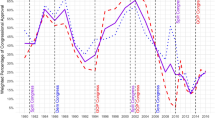Abstract
Many studies suggest that personal ideology accounts for much more of congressional voting behavior than does attention to the desires of the electorate. There are two main explanations given for this seemingly robust conclusion: 1) poor measures of constituency preferences compared to those for ideology or behavior, and 2) representatives “shirk” on an inattentive electorate. We argue that existing studies have been biased against the “interest” explanation by ignoring the structure of American Congressional elections, in particular the party primary process. Correcting for the party primary effect, we show, within the context of abortion politics, that constituency interests possess greater explanatory power than previous models would suggest.
Similar content being viewed by others
References
Bauer, R., Pool, I. and Dexter, L. (1972).American business and public policy: The politics of foreign trade. Chicago: Aldine Atherton Press.
Becker, G. (1983). A theory of competition among pressure groups for political influence.Quarterly Journal of Economics 98: 371–400.
Bell, D. (1961).The end of ideology. New York: Free Press.
Clausen, A. (1973).How congressmen decide: A policy focus. New York: St. Martin's Press.
Converse, P. (1964). The nature of belief systems in mass politics. In D. Apter (Ed.),Ideology and Discontent. Chicago: University of Illinois Press.
Downs, A. (1957).An economic theory of democracy. New York: Harper Press.
Fenno, R. (1978).Home style. Boston: Littleton, Brown Press.
Fiorina, M. (1974).Representatives, roll calls and constituencies. Lexington: Lexington Books.
Goff, B.L. and Grier, K.B. (1993). On the (mis)measurement of legislator ideology and shirking.Public Choice 76(1): 5–20.
Hansen, J.M. (1991)Gaining success: Congress and the farm lobby 1919–1981. Chicago: University of Chicago Press.
Jackson, J. and King, D.C. (1989). Public goods, private interests, and representation.American Political Science Review 83: 1143–1164.
Jackson, J. and Kingdon, J. (1992). Ideology, interest group scores, and legislative votes.American Political Science Review 36: 805–823.
Kalt, J. and Zupan, M. (1984). Capture and ideology in the economic theory of politics,American Economic Review 74: 279–300.
Kalt, J. and Zupan, M. (1990). The aparent ideological behavior of legislation: Testing for principal agent stock in political institutions.Journal of Law and Economics 33: 103–131.
Krehbiel, K. (1992). Where's the Party?British Journal of Political Science forthcoming.
Krehbiel, K. (1993). Constituency characteristics and legislative preferences.Public Choice 76(1): 21–38.
Mannheim, K. (1936).Ideology and utopia: An introduction to the sociology of knowledge. New York: K. Paul, Trench, Trubner & Co., Ltd.
Marx, K. (1970).The German ideology. 3rd edition. New York: International Publishers.
McInturff, W.D. (1989). Abortion: A Republican perspective.Campaign Magazine 3: 11–12.
Norrander, B. (1989). Ideological representativeness of presidential primary voters.American Journal of Political Science 33: 570–587.
North, D. (1981).Structure and change in economic history. New York: Norton.
Peltzman, S. (1984). Constituent interest and congressional voting.Journal of Law and Economics 27: 181–210.
Polsby, N. (1983).Consequences of party reform. Oxford: Oxford University Press.
Poole, K. and Rosenthal, H. (1985). A spatial model for legislature roll call analysis.American Journal of Political Science 29: 357–384.
Poole, K. and Rosenthal, H. (1991). Patterns of congressional voting.American Journal of Political Science 35: 228–278.
Schattschneider, E.E. (1935).Politics, pressures, and the tariff. New York: Prentice-Hall.
Schneider, J. (1979).Ideological coalitions in Congress. Westport: Greenwood Press.
Sinclair, B. (1982).Congressional realignment 1925–1978. Austin: University of Texas Press.
Stigler, G. (1971). The theory of economic regulation.The Bell Journal of Economics and Management Science 2: 3–21.
Vandoren, P. (1990). Can we learn the causes of congressional decisions from roll call data?Legislative Studies Quarterly 15: 311–340.
Yang, F. (1991). It's a matter of choice.Campaign Magazine 4: 10–13
Author information
Authors and Affiliations
Additional information
The authors would like to thank Keith Krehbiel and Morris Fiorina, as well as members of the Harvard-MIT Research Training Group in Political Economy for helpful comments. We reluctantly accept responsibility for any remaining errors.
Rights and permissions
About this article
Cite this article
Brady, D., Schwartz, E.P. Ideology and interests in congressional voting: The politics of abortion in the U.S. Senate. Public Choice 84, 25–48 (1995). https://doi.org/10.1007/BF01047799
Accepted:
Issue Date:
DOI: https://doi.org/10.1007/BF01047799




